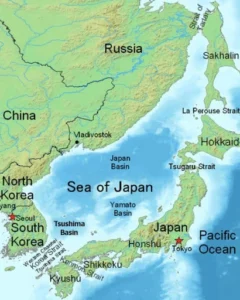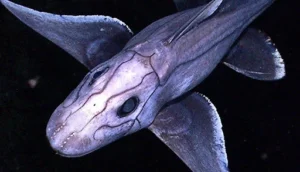UPSC GS 1
Sea of Japan
- News: Russia and China started naval exercises in the Sea of Japan recently.
- Location and Boundaries:
-
- The Sea of Japan is a marginal sea located in the western Pacific Ocean.
- It is surrounded by Russia and Sakhalin Island to the north, North Korea to the west, South Korea to the southwest, and the Japanese archipelago (including the islands of Hokkaidō, Honshū, and Kyūshū) to the east and south.
-
- Size and Area:
-
- The total area of the Sea of Japan is approximately 377,600 square miles (978,000 square kilometers).
-

- Connections to Other Bodies of Water:
-
- It is connected to the East China Sea in the south through the Tsushima and Korea Straits, and to the Okhotsk Sea in the north via the La Perouse and Tatar Straits.
- In the east, it is linked to the Inland Sea of Japan by the Kanmon Strait and to the Pacific Ocean through the Tsugaru Strait.
-
- Depth and Seafloor:
-
- The Sea of Japan has an average depth of 1,667 meters, with its deepest point located at Dohoku Seamount, an underwater volcano.
-
- Climate Influence:
-
- The relatively warm waters of the Sea of Japan play a significant role in moderating the climate of Japan, contributing to its mild conditions.
-
- Rivers and Islands:
-
- Only a few rivers flow into the Sea of Japan, accounting for less than one percent of its total water volume.
- The sea has no large islands, except for the South Korean island of Ulleungdo, with most smaller islands located near its eastern coast.
-
- Economic Activities: Mining for natural resources, such as magnetite, natural gas, and petroleum, is a key economic activity in the Sea of Japan region.
- Major Ports:
-
- Russia: Vladivostok, Sovetskaya Gavan, Nakhodka, Alexandrovsk-Sakhalinsky, and Kholmsk.
- North Korea: Hamhung, Chongjin, and Wonsan.
- Japan: Niigata, Tsuruta, and Maizuru.
-
Read also: Discover QUAD: Everything You Need to Know | UPSC
UPSC GS 2
Assam Accord
- News: The Chief Minister of Assam will implement 52 recommendations of the Justice Biplab Sarma Committee regarding Clause 6 of the Assam Accord.
- Assam Accord:
-
- The Assam Accord was a tripartite agreement signed in 1985 between the Centre, the All Assam Students Union (AASU) and the All Assam Gana Sangram Parishad (AAGSP).
- The signing of the Accord led to the conclusion of a six-year agitation that was launched by AASU in 1979, demanding the identification and deportation of illegal immigrants.
- The Accord contained: “Foreigners Issue” (Clause 5), and “Safeguards and Economic Development” (Clauses 6 and 7). There were some “Other Issues” (Clauses 8-12), and a section on “Restoration of Normalcy” (Clauses 13 and 14).
- The Home Ministry was the nodal Ministry for the implementation of the Accord.
- In 1986, “Implementation of Assam Accord Department” was set up in Assam to implement the Memorandum of Settlement.
-
- Sixth Schedule:
-
- The Sixth Schedule of the Constitution provides autonomous tribal councils in the states of Assam, Meghalaya, Tripura, and Mizoram certain legislative and judicial autonomy.
- Assam’s Sixth Schedule Areas: the Bodoland Territorial Council, the North Cachar Hills Autonomous Council and the Karbi Anglong Autonomous Council
-
- Important Clauses:
-
- Clause 5:
- For purposes of detection and deletion of foreigners, 1.1.1966 shall be the base date and year.
- Those who entered between 1966 and 1971 would be denied voting rights for ten years but retain all other citizenship rights.
- Foreigners arriving on or after March 25, 1971, were to be identified, removed from electoral rolls, and steps would be taken to expel them.
- Clause 6:
- Clause 6 mandates constitutional, legislative, and administrative safeguards to protect, preserve, and promote the cultural, social, and linguistic identity of the Assamese people.
- Since 1985, no legislation has been enacted to provide the promised constitutional protection.
- Biplab Sarma Committee Report:
- In July 2019, the Government of India formed a high-level committee, chaired by Justice Biplab Kumar Sarma, to suggest ways to implement Clause 6.
- Clause 5:
-
- Key Recommendations Implementated by Assam Government:
-
- 1951: Chief Minister of Assam accepted 1951 as the “cut-off date” for recommendations specific to the report.
- Land:
- Create Revenue Circles where only “Assamese people” can own and transfer land.
- Launch a three-year program to allot land titles to “Assamese people” without land documents.
- Special survey of char areas to treat newly created chars as government land, prioritizing river erosion-affected people for allotment.
- Language:
- Retain Assamese as the official language across the state, with provisions for local languages in the Barak Valley, Hill districts, and Bodoland.
- Make it compulsory for state government acts, rules, orders, etc. to be issued in both Assamese and English.
- Establish an Autonomous Language and Literature Academy/Council to preserve and promote indigenous languages.
- Make Assamese a compulsory subject up to class VIII or class X in English medium schools under the state board and CBSE.
- Cultural Heritage:
- Establish an autonomous authority for the development of sattras (neo-Vaishnavite monasteries) and provide them financial assistance.
- Create multipurpose cultural complexes in each district to uplift the cultural heritage of all ethnic groups.
-
Constructive Possession
- News: The Supreme Court recently ruled that under the doctrine of “constructive possession,” merely watching child pornography online, even without downloading, constitutes possession under Section 15 of the POCSO Act.
- Section 15 of the POCSO Act:
-
- Section 15 of the POCSO Act provides different punishments of varying jail terms or fine or both.
- Section 15 (1), which deals with possession of child pornographic material, provides for a minimum fine of Rs 5,000 which may extend to Rs 10,000.
- Section 15 (2), which deals with possession of child pornographic material for dissemination, entails jail term of up to three years or fine or both.
- Section 15 (3), which deals with use of such materials for commercial gains, provides for three years to five years of jail term for first-time offenders or with fine or both.
-
- Definition:
-
- Constructive possession is a legal principle that holds an individual responsible for possessing an item or substance, even if they do not have physical control or immediate possession of it.
-
- Application in Criminal Law:
-
- In criminal law, constructive possession applies when a person has the intention and ability to control an item, either individually or with others, even if it is not in their direct physical custody.
-
- Difference from Actual Possession:
-
- Unlike actual possession, which requires physical custody, constructive possession is based on the idea that a person can be held accountable for items they have the power to control, even if they are not physically carrying them.
-
- Key Elements:
-
- Intent and Capability: The doctrine revolves around an individual’s intent and capability to exercise control or dominion over the object or substance.
- Responsibility: Constructive possession allows for legal responsibility if a person controls an item, even without having it physically.
-
- Common Examples: This doctrine is often invoked in cases involving illegal drugs, firearms, or stolen property, where the individual does not have direct possession but has access or control over the item.
|
- Criteria for Prosecution:
-
- Knowledge of the Item’s Presence: The individual must be aware that the item exists. Mere proximity to the item without knowledge does not amount to constructive possession.
- Ability to Exercise Control: The person must have the capability to maintain dominion over the item, meaning they have the power and intention to control its use.
- Intent to Possess: There must be intent to possess the item, which can often be inferred from circumstances such as the item’s location and the individual’s actions or statements.
-
Supreme Audit Institutions
- News: The Comptroller and Auditor General (CAG) of India, Girish Chandra Murmu, recently assumed chairmanship of the Asian Organisation of Supreme Audit Institutions (ASOSAI) for 2024-2027.
- Supreme Audit Institutions (SAIs):
- Role and Purpose:
-
- SAIs are public oversight bodies responsible for auditing government revenue and expenditure.
- They play a vital role in a country’s accountability framework by ensuring that public financial management is transparent and resources are used appropriately.
-
- Mandate and Function: Most SAIs derive their authority from the constitution or relevant legislation. Their primary functions include:
- Financial Audits: Examining the accounting procedures and financial statements of organizations.
- Compliance Audits: Reviewing the legality of transactions made by the audited body.
- Performance Audits: Assessing the efficiency, effectiveness, or economy of government undertakings.
- Independence and Accountability: SAIs must be independent from the executive bodies they audit, which is crucial for ensuring they can hold governments accountable and foster trust between state institutions and society.
- SAI of India: In India, the Comptroller and Auditor General (CAG) and the Indian Audit and Accounts Department (IAAD) together constitute the country’s Supreme Audit Institution.
- International Organization of Supreme Audit Institutions (INTOSAI):
-
- Definition: INTOSAI is a voluntary, non-political organization aimed at promoting auditing standards, good governance, and the independence of SAIs.
- History and Membership: Founded in 1953, INTOSAI started with 34 countries and has since grown to over 192 member SAIs. It serves as the umbrella organization for the external government audit community.
- Key Functions: INTOSAI supports the work of SAIs through various committees and working groups. These groups focus on areas such as developing auditing standards for the public sector, knowledge sharing, and capacity building.
- UN Consultative Status: INTOSAI holds special consultative status with the Economic and Social Council (ECOSOC) of the United Nations.
- International Congress of Supreme Audit Institutions (INCOSAI): This is INTOSAI’s supreme organ, consisting of all members. INCOSAI meets every three years, with the chair rotating based on the host SAI.
- Governing Board: It meets annually to provide strategic leadership and continuity of INTOSAI activities between INCOSAI meetings. The Comptroller and Auditor General (CAG) of India is a member of this Governing Board.
-
Read also: Advancing MIRV Technology: India’s Agni-5 Divyastra Initiative | UPSC
UPSC GS 3
Ghost Sharks
- News: Researchers have recently discovered a new ghost shark species named Australasian Narrow-nosed Spookfish in the Chatham Rise region near New Zealand.
- About Ghost Sharks:
-
- Ghost sharks, also known as chimaeras and spookfish, are a group of cartilaginous fish that share a close relationship with sharks and rays.
- They diverged from their shark relatives nearly 400 million years ago.
-

- Features:
-
- Body Structure: Ghost sharks possess long, tapering bodies and exceptionally large heads. The maximum observed length of these fish is about 49 inches, but some individuals may grow over six feet.
- Coloration: Their skin color varies from black to pale blue to brownish-grey, complemented by haunting black eyes and smooth, light brown, scale-free skin.
- Reflective Eyes: Their eyes feature a reflective tissue layer that causes them to appear to glow in the dark, enhancing their eerie, ghostlike appearance.
- Habitat: They inhabit depths ranging from 200 meters to 2,600 meters, typically remaining close to the seafloor.
- Diet: The diet of ghost sharks primarily includes shellfish, mollusks, and worms found on or beneath the seafloor.
- Gliding Movement: Often referred to as the ocean’s butterflies, ghost sharks glide gracefully through the water using their large pectoral fins.
- Behavior: These creatures are generally considered solitary, as they are usually observed alone in their natural habitat.
-

